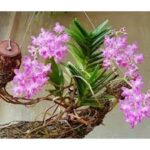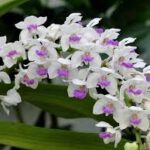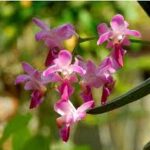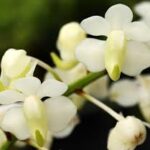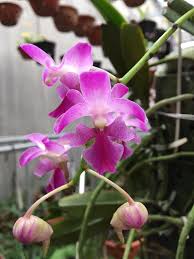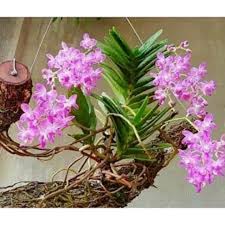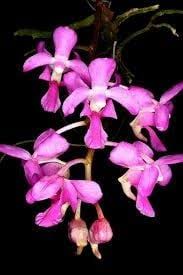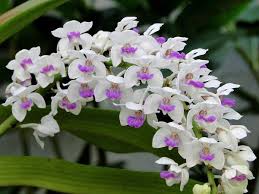
The Sato Cymbidium orchid, known for its vibrant blooms and delicate petals, is not just a beautiful addition to gardens and homes but also plays a significant role in sustainable agriculture. With their unique adaptability, aesthetic appeal, and ecological benefits, Sato Cymbidium orchids are increasingly recognized as valuable contributors to sustainable agricultural practices. In this article, we will explore the importance of Sato Cymbidium orchids in the context of sustainable development in agriculture, highlighting their environmental benefits, economic potential, and contributions to biodiversity.
#### 1. Understanding Sato Cymbidium Orchids
Sato Cymbidium orchids are a unique genus of orchids native to Asia, particularly Japan and China. They are known for their long-lasting blooms, which can come in a wide variety of colors, including yellow, white, pink, and red. These orchids thrive in various environmental conditions, making them suitable for both indoor and outdoor cultivation.
In addition to their ornamental value, Sato Cymbidium orchids are important in traditional practices. In many Asian cultures, they symbolize elegance, beauty, and love, making them popular gifts during festive occasions. The appreciation for these orchids extends beyond their visual appeal; they have cultural significance, often associated with various traditions and ceremonies.
#### 2. The Role of Orchids in Sustainable Agriculture
Sustainable agriculture aims to meet current food and resource needs without compromising future generations. This approach emphasizes ecological balance, environmental health, and economic viability. Sato Cymbidium orchids align well with these principles for several reasons:
– **Soil Health Improvement:** The cultivation of Sato Cymbidium orchids can enhance soil health. The roots of these orchids establish a symbiotic relationship with mycorrhizal fungi, which helps improve nutrient absorption and increases soil fertility. Healthier soil contributes to better crop yields in surrounding agricultural systems.
– **Biodiversity Conservation:** Sato Cymbidium orchids play a role in promoting biodiversity within ecosystems. By planting these orchids alongside traditional crops, farmers can create diverse habitats that support various beneficial insects, birds, and microorganisms. Biodiversity is crucial for ecosystem resilience, pest control, and pollination, all of which contribute to sustainable agricultural practices.
– **Water Management:** Orchids, including Sato Cymbidium, are efficient in their water usage. Their adaptation to various environmental conditions allows them to thrive with minimal water input. This characteristic makes them suitable for cultivation in areas facing water scarcity. Integrating Sato Cymbidium orchids into agricultural systems can promote sustainable water management practices and reduce overall water consumption.
#### 3. Economic Benefits of Cultivating Sato Cymbidium Orchids
The economic potential of Sato Cymbidium orchids is significant, providing farmers with alternative income sources. As demand for ornamental plants and flowers continues to rise, cultivating these orchids can offer farmers lucrative opportunities.
– **Market Demand:** The global market for ornamental plants is growing, driven by increased consumer interest in gardening, landscaping, and home decor. Sato Cymbidium orchids are sought after for their beauty and long-lasting blooms, making them a valuable product in the floral industry. By diversifying their crops with Sato Cymbidium orchids, farmers can tap into this lucrative market and increase their revenue.
– **Job Creation:** The cultivation of Sato Cymbidium orchids can create job opportunities in rural areas. From planting and caring for the orchids to harvesting and marketing, various roles are needed throughout the production process. This job creation contributes to local economies and supports community development.
– **Export Opportunities:** In regions where Sato Cymbidium orchids thrive, farmers can explore export opportunities. These orchids have a strong market presence in countries like Japan and South Korea, where they are valued for their aesthetic qualities. By meeting international quality standards, farmers can access global markets and enhance their profitability.
#### 4. Environmental Benefits of Orchid Cultivation
The environmental benefits of cultivating Sato Cymbidium orchids extend beyond soil health and biodiversity. Orchids contribute positively to the surrounding ecosystem, promoting a more sustainable approach to agriculture.
– **Carbon Sequestration:** Orchids, like all plants, play a role in carbon sequestration. Through photosynthesis, they absorb carbon dioxide and release oxygen, helping to mitigate climate change effects. Integrating Sato Cymbidium orchids into agricultural landscapes can contribute to carbon capture efforts and support global climate initiatives.
– **Pollinator Support:** Orchids are known to attract various pollinators, including bees and butterflies. These insects are essential for the pollination of many crops. By cultivating Sato Cymbidium orchids, farmers can enhance pollinator populations, which can lead to improved yields for other crops and contribute to the overall health of the ecosystem.
– **Natural Pest Control:** A diverse ecosystem, supported by the presence of Sato Cymbidium orchids, can aid in natural pest control. Beneficial insects, such as ladybugs and lacewings, thrive in habitats that include orchids. These insects can help manage pest populations, reducing the need for chemical pesticides and promoting environmentally friendly agricultural practices.
#### 5. Challenges and Solutions in Cultivating Sato Cymbidium Orchids
While the cultivation of Sato Cymbidium orchids offers numerous benefits, it is essential to acknowledge the challenges that may arise in their production. Addressing these challenges is crucial for ensuring sustainable growth.
– **Climate Sensitivity:** Sato Cymbidium orchids have specific climatic requirements for optimal growth. Changes in climate, such as increased temperatures or prolonged droughts, can affect their health and flowering potential. Implementing climate-resilient practices, such as selecting appropriate cultivation methods and incorporating shade structures, can mitigate these risks.
– **Pest and Disease Management:** Like all plants, Sato Cymbidium orchids are susceptible to pests and diseases. Effective pest management strategies, including integrated pest management (IPM) practices, can help maintain plant health. IPM focuses on using a combination of biological control, cultural practices, and minimal pesticide use to manage pest populations sustainably.
– **Knowledge Gaps:** Many farmers may lack the knowledge and skills necessary to cultivate Sato Cymbidium orchids effectively. Providing education and training programs on orchid cultivation, pest management, and sustainable practices can empower farmers to grow these orchids successfully and harness their benefits.
#### 6. Educational and Research Opportunities
As the importance of Sato Cymbidium orchids in sustainable agriculture continues to grow, educational and research initiatives are vital for advancing our understanding of their cultivation and ecological roles.
– **University Research Programs:** Collaborations between universities and agricultural organizations can lead to valuable research on Sato Cymbidium orchids. Studies can focus on their growth requirements, pest resistance, and contributions to soil health, providing farmers with data-driven insights for successful cultivation.
– **Community Workshops:** Local agricultural extension services can organize workshops and training sessions for farmers interested in growing Sato Cymbidium orchids. These programs can cover topics such as orchid care, pest management, and sustainable practices, fostering a community of knowledgeable growers.
– **Online Resources:** In the digital age, online platforms can serve as valuable resources for farmers. Websites, forums, and social media groups dedicated to orchid cultivation can provide a wealth of information, connecting growers with experts and fellow enthusiasts.
#### 7. Conclusion
Sato Cymbidium orchids represent more than just a beautiful addition to gardens; they are integral to sustainable agricultural practices. Their ability to enhance soil health, promote biodiversity, and provide economic benefits makes them a valuable asset for farmers seeking to adopt sustainable methods. By addressing the challenges of cultivation and embracing educational opportunities, we can harness the potential of Sato Cymbidium orchids to contribute positively to sustainable development in agriculture.
In the second part of this article, we will explore specific case studies of successful Sato Cymbidium orchid cultivation, highlighting innovative practices, economic impacts, and the stories of farmers who have embraced these orchids as a part of their sustainable agricultural journey. Stay tuned as we delve deeper into the fascinating world of Sato Cymbidium orchids and their role in shaping the future of sustainable farming.
### Sato Cymbidium Orchids and Sustainable Development in Agriculture (Part 2)
In the first part of this article, we explored the various benefits of Sato Cymbidium orchids within the realm of sustainable agriculture. We discussed their role in enhancing soil health, supporting biodiversity, providing economic opportunities, and contributing positively to environmental health. In this second part, we will delve deeper into specific case studies that highlight successful Sato Cymbidium orchid cultivation, innovative practices employed by farmers, and the broader impacts these orchids have on sustainable agricultural systems.
#### 1. Case Studies of Successful Sato Cymbidium Cultivation
##### A. The Rise of Urban Orchid Farms
In urban environments, where space is limited, innovative growers have found ways to cultivate Sato Cymbidium orchids in greenhouses and rooftop gardens. A notable example is an urban farm in Tokyo, Japan, where local farmers have transformed an unused warehouse into a thriving orchid production facility.
**Innovative Practices:**
– **Hydroponics:** The use of hydroponic systems allows farmers to grow Sato Cymbidium orchids without traditional soil. This method enhances water efficiency and reduces the risk of soil-borne diseases. By circulating nutrient-rich water directly to the plant roots, farmers can control nutrient levels and promote optimal growth.
– **Vertical Gardening:** Maximizing limited space, vertical gardening techniques enable farmers to grow orchids in stacked layers, increasing production capacity without requiring additional land. This method not only boosts productivity but also contributes to urban greening efforts.
**Economic Impact:**
– The urban orchid farm has become a significant contributor to the local economy, creating jobs in production, marketing, and sales. The accessibility of Sato Cymbidium orchids has encouraged local residents to engage in gardening and landscaping, promoting a culture of sustainability.
##### B. Community-Based Orchid Cultivation in Rural Areas
In rural communities, farmers have banded together to form cooperative societies dedicated to the cultivation of Sato Cymbidium orchids. These cooperatives focus on sustainable practices and share resources to improve their production methods.
**Collaborative Approaches:**
– **Resource Sharing:** By pooling resources, farmers can invest in high-quality seedlings, shared equipment, and training programs. This collaborative approach allows smaller farmers to access the market, compete with larger producers, and enhance their overall productivity.
– **Organic Practices:** Many cooperatives emphasize organic cultivation methods, avoiding synthetic fertilizers and pesticides. Instead, they utilize natural pest control methods and organic compost, promoting soil health and reducing environmental impact.
**Social and Economic Benefits:**
– The cooperative model not only increases income for participating farmers but also strengthens community ties. By working together, farmers share knowledge, experience, and support, fostering a sense of belonging and mutual assistance. This social cohesion enhances resilience against market fluctuations and environmental challenges.
#### 2. Innovative Practices in Sustainable Orchid Cultivation
As the demand for Sato Cymbidium orchids continues to rise, growers are increasingly adopting innovative practices that align with sustainable agriculture principles. These practices not only improve productivity but also minimize the environmental footprint of orchid cultivation.
##### A. Integrated Pest Management (IPM)
Sato Cymbidium orchid growers are increasingly adopting Integrated Pest Management (IPM) strategies to control pests and diseases. IPM focuses on using a combination of biological, cultural, and mechanical methods to manage pest populations while minimizing the use of chemical pesticides.
**Components of IPM:**
– **Biological Control:** Farmers introduce beneficial insects, such as ladybugs and predatory mites, to help manage pest populations naturally. This approach reduces reliance on chemical interventions and promotes ecological balance.
– **Cultural Practices:** Crop rotation, intercropping with companion plants, and proper sanitation measures help prevent pest outbreaks. By diversifying the plant environment, farmers can disrupt pest life cycles and reduce infestations.
**Benefits of IPM:**
– IPM enhances plant health and resilience, leading to better yields. By minimizing chemical inputs, growers can produce Sato Cymbidium orchids that are safer for consumers and have less impact on the surrounding ecosystem.
##### B. Sustainable Water Management
Water management is a critical aspect of sustainable agriculture, especially for orchid cultivation. Innovative practices are being implemented to conserve water and optimize its use in Sato Cymbidium production.
**Water-Saving Techniques:**
– **Drip Irrigation:** This technique delivers water directly to the plant roots, minimizing evaporation and runoff. By controlling water application, farmers can ensure that Sato Cymbidium orchids receive the right amount of moisture without wastage.
– **Rainwater Harvesting:** Growers are increasingly investing in rainwater harvesting systems to capture and store rainwater for irrigation. This practice reduces dependency on groundwater sources and promotes sustainable water use.
**Environmental Impact:**
– Sustainable water management practices contribute to the long-term viability of orchid cultivation. By conserving water resources, farmers can mitigate the impacts of drought and climate change while maintaining healthy, productive plants.
#### 3. The Role of Technology in Sustainable Orchid Cultivation
Advancements in technology are transforming the way Sato Cymbidium orchids are cultivated. Farmers are utilizing modern tools and techniques to enhance production efficiency, monitor plant health, and improve sustainability.
##### A. Precision Agriculture
Precision agriculture techniques, including the use of sensors and data analytics, are becoming increasingly popular among orchid growers. These technologies enable farmers to monitor environmental conditions and make informed decisions regarding irrigation, fertilization, and pest management.
**Key Technologies:**
– **Soil Moisture Sensors:** These sensors provide real-time data on soil moisture levels, allowing farmers to optimize irrigation schedules. By ensuring that Sato Cymbidium orchids receive the right amount of water, farmers can improve plant health and reduce water waste.
– **Climate Monitoring Systems:** Monitoring temperature, humidity, and light levels helps farmers create optimal growing conditions for orchids. By understanding the microclimate in their growing environments, farmers can make adjustments to enhance plant growth and flowering.
**Benefits of Precision Agriculture:**
– By adopting precision agriculture practices, Sato Cymbidium orchid growers can increase yields while minimizing resource use. This approach aligns with sustainable development goals and contributes to the overall efficiency of agricultural systems.
##### B. Genetic Improvement and Hybridization
The development of new hybrid varieties of Sato Cymbidium orchids is a key area of focus for researchers and growers. Genetic improvement programs aim to enhance desirable traits, such as disease resistance, flower quality, and adaptability to various environmental conditions.
**Research Initiatives:**
– Collaborations between universities and orchid breeders have led to the development of hybrid varieties that are more resilient and better suited for sustainable cultivation. These hybrids often require fewer inputs, making them more environmentally friendly.
**Market Potential:**
– The introduction of new hybrids opens up opportunities for farmers to meet consumer demands for unique colors and shapes. By diversifying their product offerings, growers can capture niche markets and increase profitability.
#### 4. Education and Outreach for Sustainable Practices
Education and outreach initiatives play a crucial role in promoting sustainable practices among Sato Cymbidium orchid growers. By providing knowledge and resources, stakeholders can empower farmers to adopt environmentally friendly cultivation methods.
##### A. Workshops and Training Programs
Local agricultural extension services and non-governmental organizations often organize workshops and training sessions for orchid growers. These programs cover various topics, including sustainable cultivation practices, pest management, and market access.
**Hands-On Learning:**
– Workshops provide hands-on training, allowing farmers to practice new techniques and learn from experts. This experiential learning fosters confidence and encourages the adoption of sustainable practices.
**Networking Opportunities:**
– Such programs also create networking opportunities for growers to connect with one another, share experiences, and collaborate on common challenges. Building a community of knowledgeable growers strengthens the overall capacity for sustainable orchid production.
##### B. Online Resources and Support
In addition to in-person training, online platforms offer valuable resources for Sato Cymbidium orchid growers. Websites, forums, and social media groups dedicated to orchid cultivation provide a wealth of information and support.
**Access to Knowledge:**
– Farmers can access articles, videos, and expert advice on various aspects of orchid cultivation. This readily available information enables them to stay updated on best practices and innovations in sustainable agriculture.
**Peer Support:**
– Online communities foster peer support, allowing growers to share their experiences, ask questions, and seek advice from others who face similar challenges. This collaborative approach enhances learning and promotes the sharing of successful practices.
#### 5. Conclusion
Sato Cymbidium orchids represent a powerful tool for promoting sustainable development in agriculture. Through innovative practices, community collaboration, and the integration of technology, growers are harnessing the potential of these beautiful flowers to enhance soil health, support biodiversity, and create economic opportunities.
As we move forward, it is essential to continue fostering research, education, and outreach efforts that empower farmers to adopt sustainable practices in Sato Cymbidium orchid cultivation. By recognizing the broader impacts of these orchids on the environment, economy, and community, we can work towards a more sustainable agricultural future.
In conclusion, Sato Cymbidium orchids are not just ornamental plants; they symbolize the potential for sustainable agricultural practices to flourish. By embracing the principles of sustainability and innovation, we can cultivate a brighter future for both farmers and the environment. The journey towards sustainable development is ongoing, and the continued cultivation of Sato Cymbidium orchids will undoubtedly play a significant role in shaping the future of agriculture.

